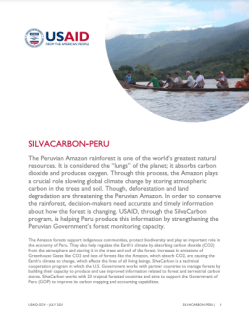The Peruvian Amazon rainforest is one of the world’s greatest natural resources. It is considered the “lungs” of the planet; it absorbs carbon dioxide and produces oxygen. Through this process, the Amazon plays a crucial role slowing global climate change by storing atmospheric carbon in the trees and soil. Though, deforestation and land degradation are threatening the Peruvian Amazon.
In order to conserve the rainforest, decision-makers need accurate and timely information about how the forest is changing. USAID, through the SilvaCarbon program, is helping Peru produce this information by strengthening the Peruvian Government’s forest monitoring capacity. SilvaCarbon works with 23 tropical forested countries and aims to support the Government of Peru (GOP) to improve its carbon mapping and accounting capabilities.
HOW DOES THE ACTIVITY WORK??
SilvaCarbon supports Peruvian agencies and academic institutions through workshops, exchange programs, and direct technical assistance. Peruvian counterparts include the Ministry of the Environment (MINAM), the Peruvian Forest and Wildlife Service (SERFOR), and the Research Institute of the Peruvian Amazon (IIAP). SilvaCarbon collaborates with the GOP to improve its forest and carbon mapping capabilities and strengthen the national forest inventory system by incorporating remote sensing data and tools to reduce monitoring costs.
RESULTS
- MINAM has greatly improved its mapping and carbon accounting capabilities as a result of SilvaCarbon support, and now has a system, which is compatible with the requirements of the Intergovernmental Panel on Climate Change (IPCC), to estimate land use change.
- SERFOR improved data analysis and reporting capabilities for the national forest inventory - a key input into the United Nations Framework Convention on Climate Change reporting requirements. This data serves to calculate the carbon stored in the forest in order to measure reductions in emissions, its composition and distribution and thus contributing to improved policy decision making.
- MINAM has developed a methodology to continuously predict the risk of deforestation and forest fires at a local scale, which provides information to decision makers and the general public before deforestation occurs.
- MINAM finalized its first forest change map and is completing the first phase of its national forest inventory.
- Intensive carbon monitoring sites were installed to increase understanding of forest-climate dynamics, build capacities for new carbon monitoring techniques, and provide research opportunities for scientists and students.

